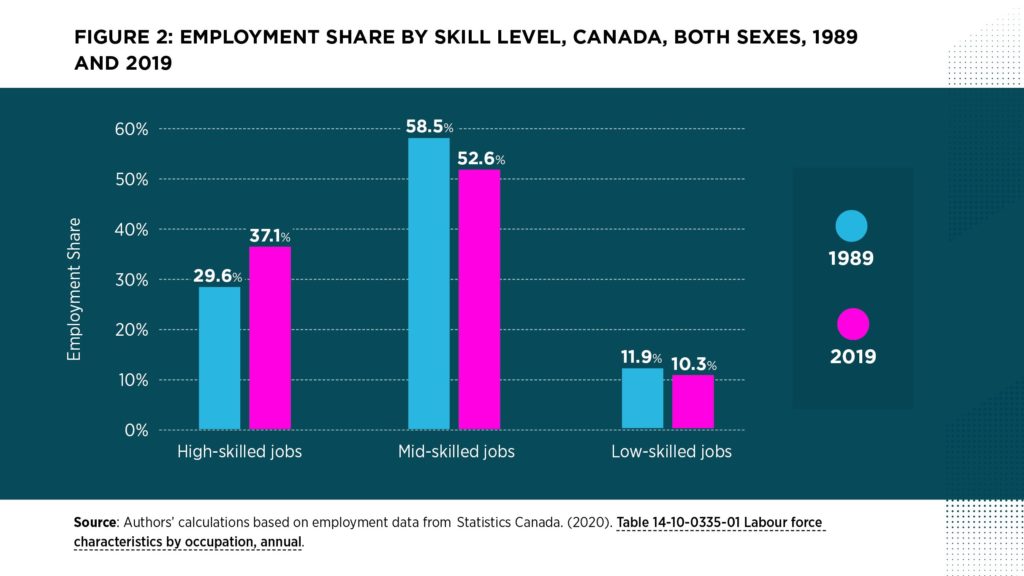Job Polarization in Canada
Job polarization is one of several trends — including automation, offshoring and the growing importance of the gig-economy — that were already of general interest prior to the onset of the pandemic, but which have been pushed even further into the centre of public policy discussions by the arrival of COVID-19. As Canadian policymakers consider how to build back the economy after the pandemic, addressing the problems created by job polarization needs to figure prominently in their priorities.
Key Takeaways
Executive Summary
Significant changes over the past 30 years in the share of low-, mid-, and high-skilled jobs in Canada’s economy represent an under-explored labour market trend. During this period, Canada has seen a continuous decline in the share of mid-skilled jobs and a steady increase in high-skilled jobs. The share of low-skilled jobs has moved slightly up and down at times but has basically been flat since 2000.
Canada’s experience is not that different from most other advanced economies over this period. Indeed, most peer countries have experienced an increase in the proportion of high-skilled jobs, a reduction in mid-skilled jobs, and an increase in low-skilled ones. This trend is commonly referred to as “job polarization.” As policymakers look to build back economies after the pandemic, these long-term shifts are important to understand and consider, particularly when high- skilled jobs pay, on average, almost four times what low-skilled ones do.
This report looks at job polarization, with the goal of helping Canadian policymakers and the general public better understand the trend, including causes, effects and how it differs among provinces, industries and workers. The goal is to facilitate a discussion and debate about these trends, what they mean for Canada’s economy, and what public-policy changes could help to minimize the more negative economic and social effects of the so-called “vanishing middle.”

Job polarization has been under way in Canada over the past three decades, though this country’s experience is less marked than the OECD average. On the whole, Canada has seen a 7.5-percentage-point increase in high-skilled occupations and declines in mid- and low-skilled ones. These changes have not been uniform across provinces. Ontario and Quebec saw mid-skilled jobs decline by more than 7.5 percentage points while British Columbia and Nova Scotia saw drops of six and five percentage points respectively. Manitoba, Saskatchewan and Prince Edward Island have actually experienced small increases in the proportion of mid-skilled jobs in their economies, though the national average still trends towards a decrease in the proportion of the population working in these kinds of jobs.
Polarization also appears to have differing effects depending on the population group, though data gaps limit how much can be said about these differing effects. Statistics Canada, therefore, has a role to play in expanding its data collection and releasing more disaggregated data to the public to improve the understanding of how polarization differs for racialized Canadians, Indigenous people, disabled Canadians and younger workers, for example.
But one thing is clear: The changes to the distribution of jobs represent a major economic, political and social development as there is less demand for the mid-skilled worker in the modern economy. Economists David Green and Benjamin Sand have warned that: “The loss of good jobs with wages that could provide financial security for less educated workers raises the spectre of an increasingly unequal society.” And an unequal society can create unrest — as it has in the U.S., where it seems to have contributed to the rise of political populism.




